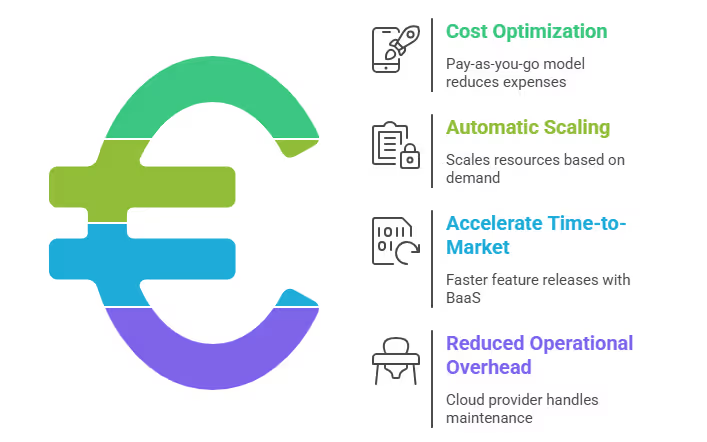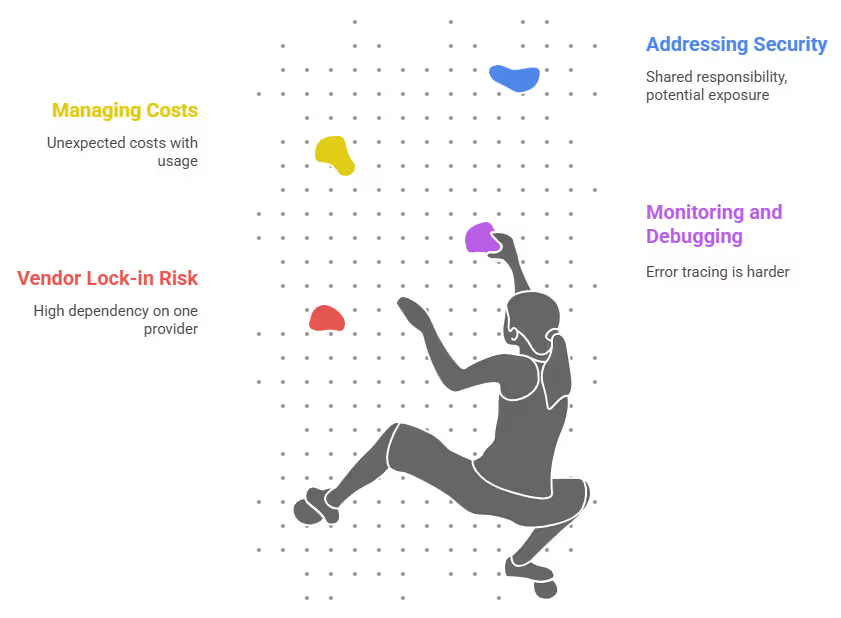Serverless App Development Services: Boost Agility

Table of Contents
What are Serverless App Development Services?
Serverless App Development Services enable businesses, particularly SaaS companies, to build and run applications without the burden of managing and maintaining the underlying servers. This approach lets you focus entirely on your product's features and core business logic, while the cloud provider (like Amazon Web Services or Google Cloud) handles the infrastructure. For SaaS businesses, this translates to faster development, reduced operational costs, and the ability to handle traffic spikes effortlessly.
It represents a fundamental shift from a traditional, server-centric mindset to a flexible, code-centric one. This change means you're no longer purchasing fixed server capacity; instead, you're buying functionality on-demand.
The core value of a serverless approach is its ability to deliver business agility. By removing the need for a lengthy infrastructure setup and management, your development teams can deploy new features and updates faster than ever. This gives your SaaS product a significant competitive advantage, allowing you to test new ideas and pivot quickly based on user feedback.
Key Benefits of Serverless for SaaS Companies
For SaaS providers, scaling and managing infrastructure often becomes a hidden challenge that slows innovation and adds cost. Serverless computing changes this model by giving teams a flexible, cost-efficient, and automated way to run applications.
The benefit is not just about saving money but creating a better balance between business agility, developer productivity, and customer experience.

Cost Optimization: From Fixed to Flexible Spending
- SaaS businesses often deal with unpredictable usage patterns where user demand spikes and dips without warning.
- Traditional hosting models charge for fixed server capacity, even when those servers stay idle.
- Serverless follows a pay-as-you-go model, so you only pay for actual execution time and resource usage, not unused capacity.
- This approach helps SaaS companies control costs, keep margins healthier, and reinvest savings back into product improvements.
Automatic Scaling for Unpredictable Traffic
- SaaS applications get sudden bursts of traffic during events like marketing promotions, new feature launches, or seasonal demand.
- Scaling servers manually or overprovisioning capacity creates wastage or downtime risk.
- With serverless, the platform automatically scales resources up or down based on demand.
- This ensures consistent performance for users, even during traffic spikes, without requiring human intervention or complex infrastructure planning.
Accelerate Time-to-Market
- SaaS growth depends on releasing features fast and improving products continuously.
- Serverless frees teams from infrastructure setup, patching, and capacity planning.
- Developers can use Backend-as-a-Service (BaaS) capabilities such as authentication, databases, and storage to launch features faster.
- This accelerates product rollout and gives companies a competitive edge in crowded SaaS markets.
- Faster delivery also improves customer loyalty since users get fresh features more often.
Reduced Operational Overhead
- Managing servers, upgrades, and security patches consumes valuable IT and DevOps resources.
- In a serverless environment, the cloud provider handles provisioning, scaling, and maintenance.
- SaaS teams no longer need to dedicate time to low-level infrastructure work.
- This lets in-house talent focus on building customer-facing features and driving innovation instead of firefighting infrastructure issues.
By adopting serverless, SaaS providers align infrastructure costs with actual demand, cut operational friction, and respond faster to market needs.
When to Use Serverless vs. Traditional Architecture
Every SaaS product has different performance needs and growth patterns. Serverless computing gives you flexibility and cost efficiency, but it does not always replace the stability and control of traditional, server-based setups.
Choosing the right architecture depends on your workload type, usage patterns, and performance goals.
Ideal Use Cases for Serverless in SaaS
Serverless architecture excels when a workload is event-driven, unpredictable, or needs to scale flexibly. This approach helps SaaS teams optimize costs while deploying new features faster.
- Scalable APIs
- Serverless is perfect for building lightweight APIs that need to handle sudden and unpredictable traffic spikes.
- This is especially beneficial for usage-based SaaS models where traffic is uneven but requires instant, reliable responses to maintain a smooth user experience.
- On-Demand Data Processing
- Use serverless to run data pipelines that process events or logs without the cost of keeping servers running around the clock.
- This approach significantly reduces infrastructure costs and improves efficiency for SaaS apps that handle large, yet irregular, data processing tasks.
- Real-Time File and Media Processing
- Tasks like image resizing, video encoding, or document parsing can be executed as serverless functions.
- This avoids overprovisioning resources and ensures you only pay for compute time when a processing task is actually running.
- Microservices Deployment
- Serverless is highly effective for modern, modular SaaS architectures built on independent microservices.
- Your teams can update and scale individual services without affecting the full application stack, which greatly increases agility and reduces risk.
- Event-Driven Workloads
- Serverless functions can be instantly triggered by specific events, such as a new user sign-up, an email notification being sent, or an IoT signal being received.
- This supports powerful automation while avoiding idle compute costs, ensuring your application responds only when necessary.
When Traditional Architectures Are a Better Fit
A traditional, server-based approach may still be the right fit for SaaS applications that demand stability, predictable performance, and more control over infrastructure.
Key scenarios include:
- Consistently High Workloads
- If your SaaS product has heavy, predictable traffic 24/7, servers can deliver better cost efficiency.
- Traditional setups avoid potential execution overhead or cold starts seen in serverless environments.
- Latency-Sensitive Applications
- Financial platforms, multiplayer gaming, or real-time collaboration tools often need microsecond-level response times.
- Traditional hosting ensures lower latency without depending on serverless execution speed.
- Legacy Applications
- Older SaaS systems may rely on specific middleware, libraries, or OS-level controls.
- Migrating them to serverless often requires extensive refactoring, making server-based hosting more practical.
- Granular Control of Environment
- When you need fine-grained management of databases, memory, or VM configurations, servers remain the stronger option.
- This is especially true if compliance or security requirements demand full control of infrastructure.
- Long-Running Processes
- Workloads like machine learning training or complex report generation run for hours.
- Traditional servers handle such continuous processing better since serverless functions often have time limits.
Serverless App Development - Challenges
Migrating to a serverless model helps businesses scale faster and spend less time on infrastructure. At the same time, it comes with its own set of challenges. The good news is that these challenges can be solved with the right planning and best practices.
Below are some of the most common issues and effective ways to address them:

Risk of Vendor Lock-in
- Relying too much on the tools and services of one cloud provider can create dependency.
- If business needs change in the future, switching to another platform may require high effort and cost.
- To reduce this risk, we use cloud-agnostic architectures where possible.
- Multi-cloud strategies are adopted thoughtfully, making services flexible without adding unnecessary complexity.
Difficulties in Monitoring and Debugging
- Serverless systems run as distributed functions, which makes error tracing harder than in traditional setups.
- Simple logging is not enough to understand how different functions interact.
- We use modern observability tools that provide end-to-end visibility into function performance.
- These tools make debugging faster, help detect bottlenecks, and improve response times for fixes.
Managing Costs Effectively
- The pay-per-execution billing model can cause surprise costs when functions run longer or get more traffic than expected.
- Businesses sometimes underestimate costs from background events or third-party API calls.
- We overcome this by setting clear monitoring rules, creating dashboards for runtime usage, and applying usage alerts.
- Cost visibility gives clients better control and aligns spending with their growth goals.
Addressing Security Concerns
- In serverless, responsibility for security is shared between the cloud provider and the business.
- Misconfigured access permissions or unmanaged dependencies can expose sensitive data.
- We follow strict security protocols including encryption, role-based access, and automated policy checks.
- Leveraging built-in provider features such as identity management ensures stronger security for every function.
By tackling these challenges with a proactive approach, serverless applications can deliver real benefits without unexpected risks.
Businesses that follow these practices enjoy agility, scalability, and cost savings while staying in control.
Our Approach to Serverless Development for SaaS
Building a successful SaaS product on serverless technologies requires more than just choosing the right cloud services. It needs a clear strategy, thoughtful design, agile execution, and consistent optimization.
Our structured approach ensures your solution isn’t just cost-effective, it grows with your business.
1. Discovery and Strategy
- We start by learning about your business goals, customer needs, and industry requirements.
- This helps us identify where serverless can create the most value, whether in scalability, faster development, or lower operational costs.
- We also review your existing tech stack and suggest ways to make the transition smooth without disrupting ongoing operations.
- The outcome is a custom serverless roadmap that aligns with both short-term product goals and long-term growth plans.
2. Architecture and Design
- Our architects design modular and event-driven systems that can scale automatically during high usage and stay cost-efficient during low demand.
- The focus is on resilience and adaptability, so your SaaS can handle new features and user traffic without painful rework.
- We choose the right cloud-native services like AWS Lambda, Azure Functions, or Google Cloud Functions, ensuring flexibility and avoiding unnecessary vendor lock-in.
- Security and compliance are built into the design stage, not just added later.
3. Development and Deployment
- We adopt agile development cycles, making sure every new feature is tested and released quickly.
- Our team uses automated CI/CD pipelines to reduce manual errors, shorten release cycles, and enable faster iterations.
- On the front end, we build responsive and user-friendly web apps that deliver a smooth experience, while the back end runs efficiently on serverless services.
- Every deployment is designed to be repeatable and transparent, so scaling your SaaS feels effortless.
4. Post-Launch Support and Optimization
- Launch is not the finish line, it’s the start of growth. We provide ongoing monitoring to track app health, performance, and costs in real time.
- We continuously analyze usage data and make improvements to ensure the system stays optimized as user demand changes.
- Our support covers feature upgrades, cost tuning, and workload optimization, so your SaaS evolves along with your market.
- This model ensures your product stays reliable, competitive, and aligned with modern best practices in serverless computing.
Real-World Serverless Success Stories
Serverless computing is transforming SaaS businesses by taking away the pain of managing infrastructure, so teams can focus purely on product and user experience.
Here’s how companies across different industries are using serverless to solve real business problems, save money, and scale effortlessly:
- Coca-Cola adopted serverless for its Freestyle IoT-powered vending machines, which let users order and pay online. The platform easily scaled from an anticipated 30million requests to over 80million, while reducing costs per machine from $13,000 to $4,500 by paying only for actual usage. This shift to serverless enabled agility and cost-efficiency, supporting surges in customer demand and contactless buying during the pandemic.
- Neiman Marcus, a major luxury retailer, migrated its app development to serverless. This move sped up their app deployment cycles by over 50%. They were able to launch updates faster and cut down development costs, which gave them more room to innovate and respond quickly to shoppers’ needs, a competitive advantage in retail.
- Netflix relies heavily on AWS serverless to support its global streaming services. This lets them deploy thousands of servers and storage on demand, personalize recommendations more effectively, and scale quickly to handle spikes in traffic. Serverless powers rapid launches and stable operations for their worldwide audience, critical in the fast-moving entertainment industry.
- A generative AI chatbot built for accessibility used AWS Lambda and DynamoDB to offer conversational support. By adopting a serverless approach, the team delivered a cost-effective, instantly scalable chatbot for users who need help, without worrying about backend maintenance or capacity planning. This enables focused innovation and fast feature rollouts.
- SQQUID, a SaaS provider for retail automation, built its entire business on serverless from day one. This decision meant they could operate with a smaller development team, launch new features quickly, and dramatically reduce infrastructure costs, key for startups needing to compete with bigger brands.

